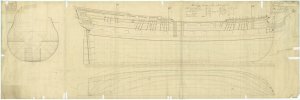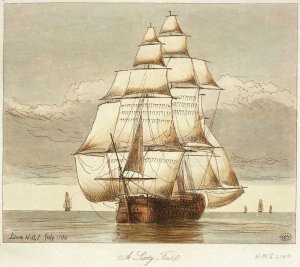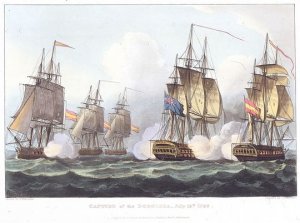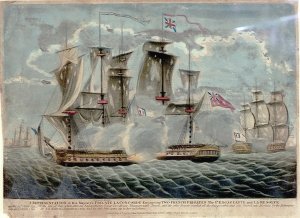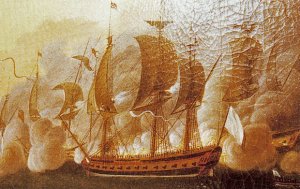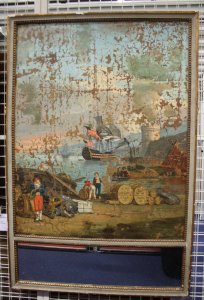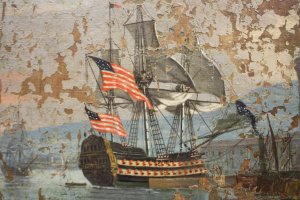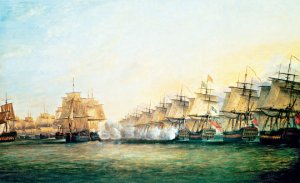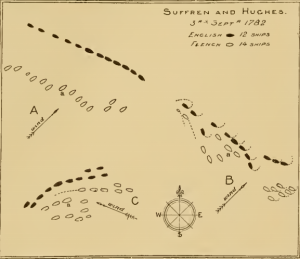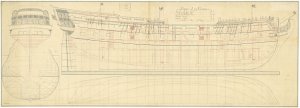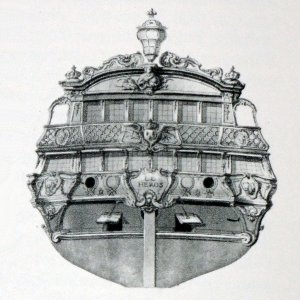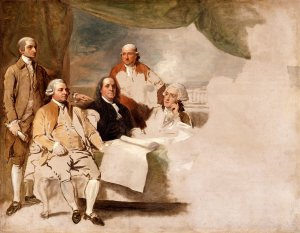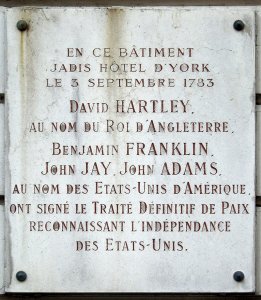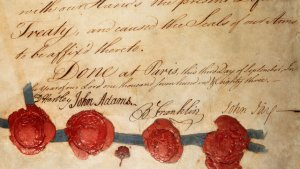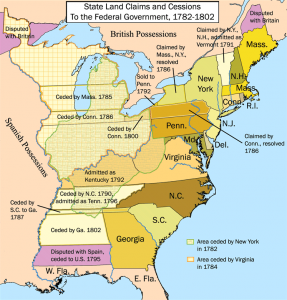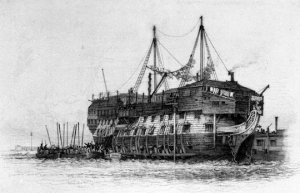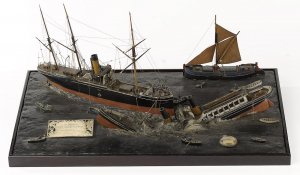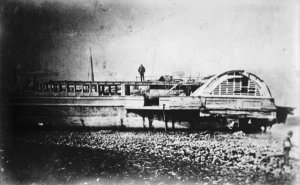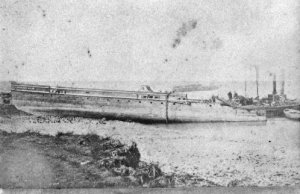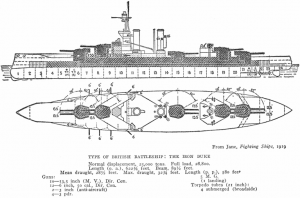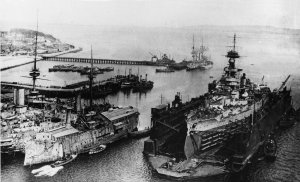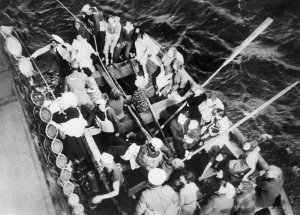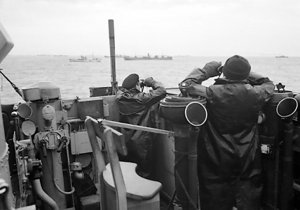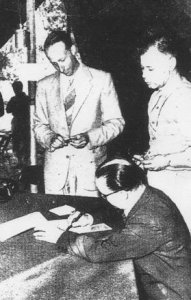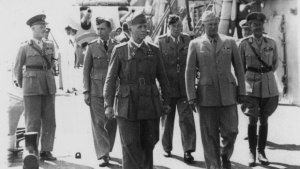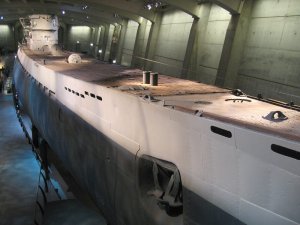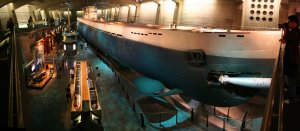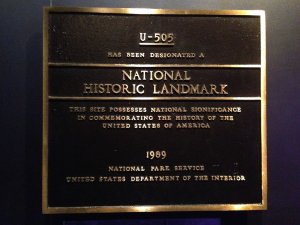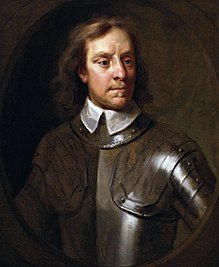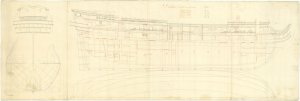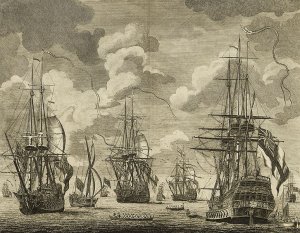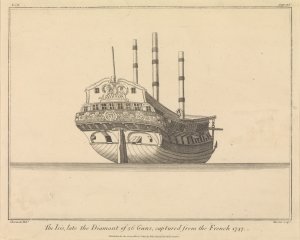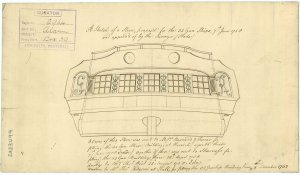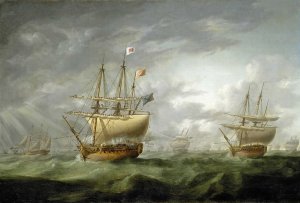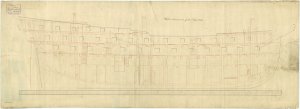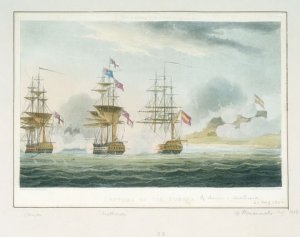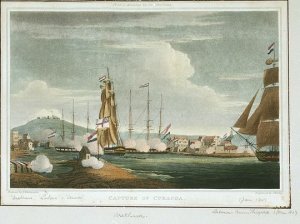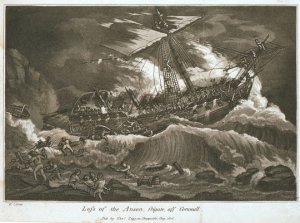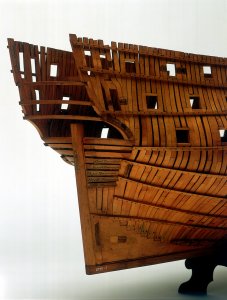Today in Naval History - Naval / Maritime Events in History
3 September HMS Coronation (1685 - 90) and HMS Harwich (1674 - 70) sank in a storm whilst attempting to get into Plymouth Sound, appr. 1.000 of their crews drowned
Summer 1691. England was at war with her old enemy France, and the fleet were busy trying to lure the French and Dutch Navies out of the relative safety of the Channel Ports. The French however, knew when they were on to a good thing, and lay snug in their harbours whilst the English Fleet was battered by some of the worst summer storms anybody could remember. In late August, during a particularly bad gale, much of the Fleet retired to shelter in Torbay, and amongst those ships was the 90 gun second rate man of war, Coronation.

Unknown maker, model of the "Coronation," 1677, boxwood, gold leaf, japanning, mica, brass, and varnish, The Kriegstein Collection
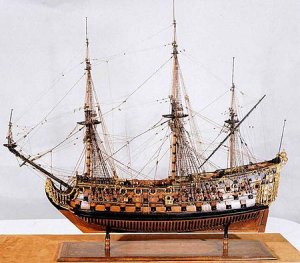

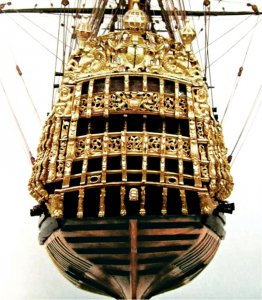
Launched in 1685 the Coronation was 140 feet long and weighed some 1366 tons. Commanded by Captain Charles Skelton, the Coronation should have had a ships complement of 660 officers and men, but due to manpower shortages it was unlikely that she was up to full strength and was probably managing with up to 100 men less than she needed. Whether this was to have some bearing on subsequent events I leave for the reader to decide.
After a couple of days the weather took a turn for the better and once more the Fleet, including the Coronation, sailed forth to blockade the French ports. Unfortunately on the first of September, when the Fleet was off Ushant, the weather turned extremely nasty and once more the ships had to turn tail, this time making for the safety of Plymouth Sound. The French must have laughed fit to burst, for the storms were accomplishing more than their own Navy had dreamed possible. Worse was to follow.
Most people know that Plymouth Sound provides one of the best natural harbours in England, well protected from southwesterly gales by a very effective breakwater. However in 1691 the breakwater had not even been thought of, and when the southwesterly gales blew, the safe haven of Plymouth Sound often turned into a raging deathtrap. Imagine that night of September 3 1691. Southwest winds of hurricane force blowing right across the Sound. The Fleet lashed by torrential rain and forced to take in all canvas. Communications with the flagship impossible. What to do? off Penlee or Rame Head and risk dragging onto a lee shore, or take a calculated risk and press on into the Sound. If you could miss Drakes Island and avoid being smashed onto the Hamoaze, you would be home and dry. If not disaster and a ruined career.
off Penlee or Rame Head and risk dragging onto a lee shore, or take a calculated risk and press on into the Sound. If you could miss Drakes Island and avoid being smashed onto the Hamoaze, you would be home and dry. If not disaster and a ruined career.
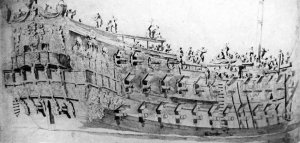
Van de Velde painting of the Harwich (NMM)
In the end some of the Fleet elected to anchor off Rame Head, and some like the HMS Harwich, took the gamble and plunged into the maelstrom. She did not get far; in fact she didn’t even make the Sound but ripped onto the rocks near Maker Point. There was no hope for her, and she quickly smashed to pieces drowning 450 of her crew. Other ships followed the Harwich, some were successful, others foundered in the Hamoaze, ran aground at the Cattewater, or simply ran into each other. The carnage was fearful.
But what of the Coronation? Well she was still somewhere between Rame Head and Penlee Point, and what happened next is largely a matter for conjecture. All we do know for certain is that she was anchored somewhere between Rame and Penlee, apparently completely dismasted with only an ensign flying from her stern. A rainsquall obliterated her, and when visibility returned the Coronation had sunk killing Captain Skelton and all but twenty of his crew. We can only imagine that Skelton had decided to have a go at sailing into the Sound when he became dismasted. Perhaps he didn’t get his sails reefed in time. Whatever the cause he would have lost control of the vessel and found himself heading for the rocky shore at an alarming rate. In a vain effort to regain control he must have slipped his anchors, but the strain of bringing the Coronation up short in those murderous seas must have been her downfall. Maybe she took on too much water and foundered, or maybe she just started to break up. In any event, whatever the cause, down she went with well over 500 officers and men. That one night shocked the Nation. Over a thousand men were killed, and the damage done to the Navy was worse than a dozen sorties against the French. But the pressures on a country during a long war are many, and soon the shock of that terrible night receded, and by the turn of the century nine years later, I doubt anybody really remembered it.
The Ships:
HMS Coronation was a 90-gun second-rate ship of the line of the English Royal Navy, built at Portsmouth Dockyard as part of the '30 great ships programme' of 1677, and launched in 1685. She was lost in a storm off Rame Head, Cornwall on 29 October 1690 and is designated as a protected wreck under the Protection of Wrecks Act 1973. The area has been subjected to a geophysical survey and it is possible to acquire a licence and dive on the site
Service
Coronation was commissioned on 14 February 1690 under Captain John Munden, as the flagship of Vice-Admiral Sir Ralph Delavall, under whom she took part in the Battle of Beachy Head, against the French, on 30 June 1690. The French won the battle and had temporary control of the English Channel. Captain Charles Skelton took command of the ship on 29 October 1690.
Loss
On 3 September 1691 Coronation was patrolling the channel with the English Fleet and made for Plymouth. The exact circumstances are unclear but it is thought she dragged her anchors while trying to sit out a south-east gale in the lee of Rame Head and was driven aground in Lady Cove to the west of Penlee Point; approximately 600 men drowned, including Skelton. Only circa twenty survived.
Diver trail
Part of the wreck was discovered, close to the shore in 1967 and a second offshore site was found in 1977. The area is subject to strong tidal flows, especially during spring tides. The main wreck site extends in a south-west direction, over 1300m, from the southern side of Penlee Point and artefacts are spread over a large area. The site is a protected wreck, but divers can visit it under licence. Many cannon are visible.
HMS Harwich was a 70-gun third rate ship of the line of the English Royal Navy, built by Sir Anthony Deane at Harwich and launched in 1674. By 1685 she was carrying only 64 guns.
https://en.wikipedia.org/wiki/HMS_Coronation_(1685)
https://en.wikipedia.org/wiki/HMS_Harwich_(1674)
Text taken partly from
http://www.submerged.co.uk/coronationandpenleecannons.php
Photos partly from the very interesting page of my austrian modeling friends
http://www.schifferlbauer.com/index.html
3 September HMS Coronation (1685 - 90) and HMS Harwich (1674 - 70) sank in a storm whilst attempting to get into Plymouth Sound, appr. 1.000 of their crews drowned
Summer 1691. England was at war with her old enemy France, and the fleet were busy trying to lure the French and Dutch Navies out of the relative safety of the Channel Ports. The French however, knew when they were on to a good thing, and lay snug in their harbours whilst the English Fleet was battered by some of the worst summer storms anybody could remember. In late August, during a particularly bad gale, much of the Fleet retired to shelter in Torbay, and amongst those ships was the 90 gun second rate man of war, Coronation.

Unknown maker, model of the "Coronation," 1677, boxwood, gold leaf, japanning, mica, brass, and varnish, The Kriegstein Collection



Launched in 1685 the Coronation was 140 feet long and weighed some 1366 tons. Commanded by Captain Charles Skelton, the Coronation should have had a ships complement of 660 officers and men, but due to manpower shortages it was unlikely that she was up to full strength and was probably managing with up to 100 men less than she needed. Whether this was to have some bearing on subsequent events I leave for the reader to decide.
After a couple of days the weather took a turn for the better and once more the Fleet, including the Coronation, sailed forth to blockade the French ports. Unfortunately on the first of September, when the Fleet was off Ushant, the weather turned extremely nasty and once more the ships had to turn tail, this time making for the safety of Plymouth Sound. The French must have laughed fit to burst, for the storms were accomplishing more than their own Navy had dreamed possible. Worse was to follow.
Most people know that Plymouth Sound provides one of the best natural harbours in England, well protected from southwesterly gales by a very effective breakwater. However in 1691 the breakwater had not even been thought of, and when the southwesterly gales blew, the safe haven of Plymouth Sound often turned into a raging deathtrap. Imagine that night of September 3 1691. Southwest winds of hurricane force blowing right across the Sound. The Fleet lashed by torrential rain and forced to take in all canvas. Communications with the flagship impossible. What to do?
 off Penlee or Rame Head and risk dragging onto a lee shore, or take a calculated risk and press on into the Sound. If you could miss Drakes Island and avoid being smashed onto the Hamoaze, you would be home and dry. If not disaster and a ruined career.
off Penlee or Rame Head and risk dragging onto a lee shore, or take a calculated risk and press on into the Sound. If you could miss Drakes Island and avoid being smashed onto the Hamoaze, you would be home and dry. If not disaster and a ruined career.
Van de Velde painting of the Harwich (NMM)
In the end some of the Fleet elected to anchor off Rame Head, and some like the HMS Harwich, took the gamble and plunged into the maelstrom. She did not get far; in fact she didn’t even make the Sound but ripped onto the rocks near Maker Point. There was no hope for her, and she quickly smashed to pieces drowning 450 of her crew. Other ships followed the Harwich, some were successful, others foundered in the Hamoaze, ran aground at the Cattewater, or simply ran into each other. The carnage was fearful.
But what of the Coronation? Well she was still somewhere between Rame Head and Penlee Point, and what happened next is largely a matter for conjecture. All we do know for certain is that she was anchored somewhere between Rame and Penlee, apparently completely dismasted with only an ensign flying from her stern. A rainsquall obliterated her, and when visibility returned the Coronation had sunk killing Captain Skelton and all but twenty of his crew. We can only imagine that Skelton had decided to have a go at sailing into the Sound when he became dismasted. Perhaps he didn’t get his sails reefed in time. Whatever the cause he would have lost control of the vessel and found himself heading for the rocky shore at an alarming rate. In a vain effort to regain control he must have slipped his anchors, but the strain of bringing the Coronation up short in those murderous seas must have been her downfall. Maybe she took on too much water and foundered, or maybe she just started to break up. In any event, whatever the cause, down she went with well over 500 officers and men. That one night shocked the Nation. Over a thousand men were killed, and the damage done to the Navy was worse than a dozen sorties against the French. But the pressures on a country during a long war are many, and soon the shock of that terrible night receded, and by the turn of the century nine years later, I doubt anybody really remembered it.
The Ships:
HMS Coronation was a 90-gun second-rate ship of the line of the English Royal Navy, built at Portsmouth Dockyard as part of the '30 great ships programme' of 1677, and launched in 1685. She was lost in a storm off Rame Head, Cornwall on 29 October 1690 and is designated as a protected wreck under the Protection of Wrecks Act 1973. The area has been subjected to a geophysical survey and it is possible to acquire a licence and dive on the site
Service
Coronation was commissioned on 14 February 1690 under Captain John Munden, as the flagship of Vice-Admiral Sir Ralph Delavall, under whom she took part in the Battle of Beachy Head, against the French, on 30 June 1690. The French won the battle and had temporary control of the English Channel. Captain Charles Skelton took command of the ship on 29 October 1690.
Loss
On 3 September 1691 Coronation was patrolling the channel with the English Fleet and made for Plymouth. The exact circumstances are unclear but it is thought she dragged her anchors while trying to sit out a south-east gale in the lee of Rame Head and was driven aground in Lady Cove to the west of Penlee Point; approximately 600 men drowned, including Skelton. Only circa twenty survived.
Diver trail
Part of the wreck was discovered, close to the shore in 1967 and a second offshore site was found in 1977. The area is subject to strong tidal flows, especially during spring tides. The main wreck site extends in a south-west direction, over 1300m, from the southern side of Penlee Point and artefacts are spread over a large area. The site is a protected wreck, but divers can visit it under licence. Many cannon are visible.
HMS Harwich was a 70-gun third rate ship of the line of the English Royal Navy, built by Sir Anthony Deane at Harwich and launched in 1674. By 1685 she was carrying only 64 guns.
https://en.wikipedia.org/wiki/HMS_Coronation_(1685)
https://en.wikipedia.org/wiki/HMS_Harwich_(1674)
Text taken partly from
http://www.submerged.co.uk/coronationandpenleecannons.php
Photos partly from the very interesting page of my austrian modeling friends
http://www.schifferlbauer.com/index.html
Last edited:





